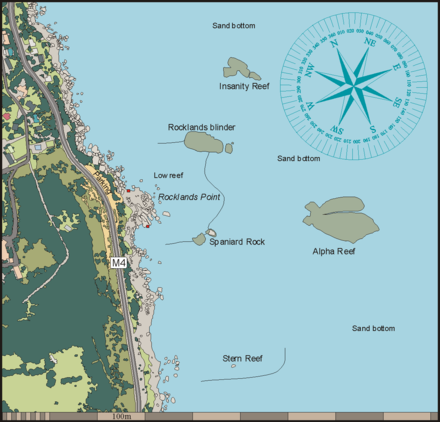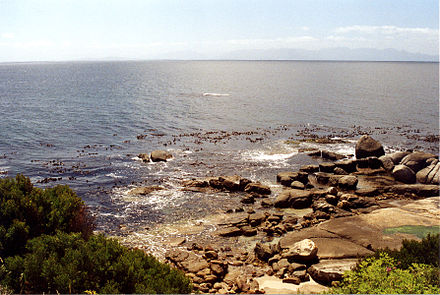Diving the Cape Peninsula and False Bay/Spaniard Rock - inshore dive site at Rocklands Point on the Cape Peninsula east coast
The dive site Spaniard Rock or Rocklands Point is an inshore rocky reef in the Rocklands Point area on the False Bay coast of the Cape Peninsula, near Cape Town in the Western Cape province of South Africa.
Understand

See also: Diving the Cape Peninsula and False Bay#Understand
Position
- Spaniard Rock 📍: S34°13.03’ E018°28.03’ — A high, steep sided and flattish topped granite pinnacle that extends a few metres above the water off Rocklands Point. It is the only rock of this description and is unmistakable.
This site is in a Marine Protected Area (2004). A permit is required.
Name
Local legend claims that the rock is named "Spaniard Rock" for the colourful invertebrate encrustation which shares colours with the Spanish Flag. More plausible reasons are not known at this time. "Rocklands Point" is descriptive, and is the name given to the point on maps and charts, but it is ambiguous, as there are several dive sites at Rocklands Point
Depth
Maximum depth is about 13 m on the sand beyond the rocks.
Topography
Spaniard rock is a high pinnacle from sand at about 12 m on south and east sides, to a couple of metres above the water. Contiguous low reef lies to the north. To the west is another pinnacle comprising a group of big corestone outcrops and boulders, one of which breaks surface occasionally. This is a much larger group than Spaniard Rock proper, and has deep crevices and overhangs. Between this group and shore is a lot of lower reef, with a bit of sand in the gaps
The water gets deep quite quickly on the south side of the entry area. The smaller pinnacle to the west extends just above water at mid tide, and is awash at high tide. There are several other fairly large boulders around it and to the south the bottom of coarse shelly sand is at about 10 m. A gap of several metres to the east separates this group from Spaniard Rock proper, which is very sheer on the south and east sides, down to a sand bottom at 11 to 12 m. There are a few low outcrops further East, and bigger boulders to the north.
Geology: Granite of the late Pre-Cambrian Peninsula pluton
Conditions
Suitable if entry conditions are OK. Best if sea is flat or swell very low. Usually considered a winter dive site, and is sheltered from westerly winds and swell. The site is exposed to south easterly winds and waves, which could cause exit conditions to deteriorate during a dive. If this happens, consider the longer swim to the more sheltered north exit area.
Facilities
Parking at the side of the M4 on a wide gravel verge near a sign warning against feeding baboons.
Get in
See also: Diving the Cape Peninsula and False Bay#Boat dives
Traditionally a shore dive, but not dived as much from the shore as it used to be. There is adequate parking on gravel shoulder on seaward side of main road, near the signpost warning against baboons. Access to the shore is poor. There are several steep eroded paths, some worse than others. Choose the one that looks best on the day. All are slippery and steep, with loose gravel. If you have a large group it may be worth arranging a rope for safety, otherwise a walking stick or staff would be useful. The climb from the roadside to the rocks is the worst part of the exercise as it is steep and slippery.
The exit point to the north of the little promontory is good, entry to the south could be a bit shaky if swells are running, but if it is too rough, it is probably not a good day for a shore dive at this site.
 The alternative exit is the north entry and exit point, which is more sheltered, but a significantly longer swim. Make your choice on the day to suit conditions.
The alternative exit is the north entry and exit point, which is more sheltered, but a significantly longer swim. Make your choice on the day to suit conditions.
Boat access is 1.6 km from Miller's Point slipway and ?? km from Simon's Town jetty.

See
Marine life
See also: Diving the Cape Peninsula and False Bay#The marine ecology
Dense kelp forests close inshore, thinning out with depth, and colourful encrustations of invertebrates, particularly on the steep and overhanging surfaces in the deeper areas.
Photography
Good site for photography. (photographic equipment suggestions)
Routes
Entry at the flat rock facing Miller's Point. Surface swim to inner pinnacle, descend, dive round the group of rocks, then west to the main pinnacle, round the main pinnacle then on a compass course to exit at the north entry and exit point. On the way back to shore on 300° magnetic there are a number of big boulders and then gullies and ridges leading into shallow water. These must be avoided and passed round to the north. Keep in water deeper than 5m with the slope up to your left to stay out of the worst of the surge until you get to the exit area, which is beyond a large smoothly sloping rock surface encrusted with nubbly encrusting corallines, colonial ascidians and sea urchins, with scattered kelp, then stay in the middle of the gap for the easiest exit.
Stay safe
See also: Diving the Cape Peninsula and False Bay#Stay safe
Hazards
The path is steep and slippery and usually in poor repair.
Skills
No special skills required for the dive. Some fitness and agility is required for the climb down and back up to the road. A suitable site for competent snorkellers.
Equipment
See also: Diving the Cape Peninsula and False Bay#Equipment
A light will be useful to look into crevices and overhangs, and a compass will help to navigate back at the end of the dive.
Nearby
- Insanity Reef 📍
- Omega Reef 📍
- Rocklands Blinder 📍
- Alpha Reef 📍
- Stern Reef 📍
- SAS Pietermaritzburg 📍
- Caravan Reef - PMB Pinnacles 📍
- Caravan Reef - North Caravan 📍
- Caravan Reef - Caravan Central, east pinnacle 📍
- Caravan Reef - Inner Caravan 📍
- Caravan Reef - South Caravan 📍
Back to the Alphabetical list of sites, or list of dive sites in the Rocklands Point area
Other regional dive sites:
Spaniard Rock
Timezone:MultipleCoordinates:-34.22, 18.47